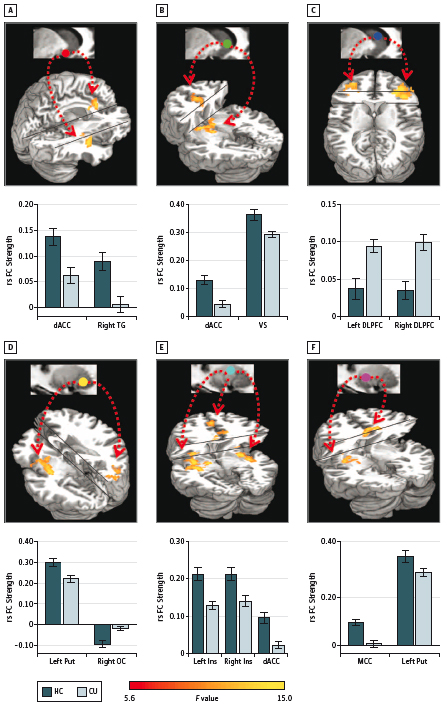Featured Paper of the Month – November 2015
Hu, Yuzheng; Salmeron, Betty Jo; Gu, Hong; Stein, Elliot A; Yang, Yihong
In: JAMA Psychiatry, vol. 72, no. 6, pp. 584–592, 2015, ISSN: 2168-6238 (Electronic); 2168-622X (Linking).
@article{Hu2015,
title = {Impaired functional connectivity within and between frontostriatal circuits and its association with compulsive drug use and trait impulsivity in cocaine addiction.},
author = {Yuzheng Hu and Betty Jo Salmeron and Hong Gu and Elliot A Stein and Yihong Yang},
url = {https://www.ncbi.nlm.nih.gov/pubmed/25853901},
doi = {10.1001/jamapsychiatry.2015.1},
issn = {2168-6238 (Electronic); 2168-622X (Linking)},
year = {2015},
date = {2015-06-01},
journal = {JAMA Psychiatry},
volume = {72},
number = {6},
pages = {584--592},
address = {Neuroimaging Research Branch, Intramural Research Program National Institute on Drug Abuse, Baltimore, Maryland.},
abstract = {IMPORTANCE: Converging evidence has long identified both impulsivity and compulsivity as key psychological constructs in drug addiction. Although dysregulated striatal-cortical network interactions have been identified in cocaine addiction, the association between these brain networks and addiction is poorly understood. OBJECTIVES: To test the hypothesis that cocaine addiction is associated with disturbances in striatal-cortical communication as captured by resting-state functional connectivity (rsFC), measured from coherent spontaneous fluctuations in the blood oxygenation level-dependent functional magnetic resonance imaging signal, and to explore the relationships between striatal rsFC, trait impulsivity, and uncontrolled drug use in cocaine addiction. DESIGN, SETTING, AND PARTICIPANTS: A case-control, cross-sectional study was conducted at the National Institute on Drug Abuse Intramural Research Program outpatient magnetic resonance imaging facility. Data used in the present study were collected between December 8, 2005, and September 30, 2011. Participants included 56 non-treatment-seeking cocaine users (CUs) (52 with cocaine dependence and 3 with cocaine abuse) and 56 healthy individuals serving as controls (HCs) matched on age, sex, years of education, race, estimated intelligence, and smoking status. MAIN OUTCOMES AND MEASURES: Voxelwise statistical parametric analysis testing the rsFC strength differences between CUs and HCs in brain regions functionally connected to 6 striatal subregions defined a priori. RESULTS: Increased rsFC strength was observed predominantly in striatal-frontal circuits; decreased rsFC was found between the striatum and cingulate, striatal, temporal, hippocampal/amygdalar, and insular regions in the CU group compared with the HCs. Increased striatal-dorsal lateral prefrontal cortex connectivity strength was positively correlated with the amount of recent cocaine use (uncorrected P < .046) and elevated trait impulsivity in the CUs (uncorrected P < .012), and an index reflecting the balance between striatal-dorsal anterior cingulate cortex and striatal-anterior prefrontal/orbitofrontal cortex circuits was significantly associated with loss of control over cocaine use (corrected P < .012). CONCLUSIONS AND RELEVANCE: Cocaine addiction is associated with disturbed rsFC in several specific striatal-cortical circuits. Specifically, compulsive cocaine use, a defining characteristic of dependence, was associated with a balance of increased striatal-anterior prefrontal/orbitofrontal and decreased striatal-dorsal anterior cingulate connectivity; trait impulsivity, both a risk factor for and a consequence of cocaine use, was associated with increased dorsal striatal-dorsal lateral prefrontal cortex connectivity uniquely in CUs. These findings provide new insights toward the neurobiological mechanisms of addiction and suggest potential novel therapeutic targets for treatment.},
keywords = {},
pubstate = {published},
tppubtype = {article}
}
IMPORTANCE: Converging evidence has long identified both impulsivity and compulsivity as key psychological constructs in drug addiction. Although dysregulated striatal-cortical network interactions have been identified in cocaine addiction, the association between these brain networks and addiction is poorly understood. OBJECTIVES: To test the hypothesis that cocaine addiction is associated with disturbances in striatal-cortical communication as captured by resting-state functional connectivity (rsFC), measured from coherent spontaneous fluctuations in the blood oxygenation level-dependent functional magnetic resonance imaging signal, and to explore the relationships between striatal rsFC, trait impulsivity, and uncontrolled drug use in cocaine addiction. DESIGN, SETTING, AND PARTICIPANTS: A case-control, cross-sectional study was conducted at the National Institute on Drug Abuse Intramural Research Program outpatient magnetic resonance imaging facility. Data used in the present study were collected between December 8, 2005, and September 30, 2011. Participants included 56 non-treatment-seeking cocaine users (CUs) (52 with cocaine dependence and 3 with cocaine abuse) and 56 healthy individuals serving as controls (HCs) matched on age, sex, years of education, race, estimated intelligence, and smoking status. MAIN OUTCOMES AND MEASURES: Voxelwise statistical parametric analysis testing the rsFC strength differences between CUs and HCs in brain regions functionally connected to 6 striatal subregions defined a priori. RESULTS: Increased rsFC strength was observed predominantly in striatal-frontal circuits; decreased rsFC was found between the striatum and cingulate, striatal, temporal, hippocampal/amygdalar, and insular regions in the CU group compared with the HCs. Increased striatal-dorsal lateral prefrontal cortex connectivity strength was positively correlated with the amount of recent cocaine use (uncorrected P < .046) and elevated trait impulsivity in the CUs (uncorrected P < .012), and an index reflecting the balance between striatal-dorsal anterior cingulate cortex and striatal-anterior prefrontal/orbitofrontal cortex circuits was significantly associated with loss of control over cocaine use (corrected P < .012). CONCLUSIONS AND RELEVANCE: Cocaine addiction is associated with disturbed rsFC in several specific striatal-cortical circuits. Specifically, compulsive cocaine use, a defining characteristic of dependence, was associated with a balance of increased striatal-anterior prefrontal/orbitofrontal and decreased striatal-dorsal anterior cingulate connectivity; trait impulsivity, both a risk factor for and a consequence of cocaine use, was associated with increased dorsal striatal-dorsal lateral prefrontal cortex connectivity uniquely in CUs. These findings provide new insights toward the neurobiological mechanisms of addiction and suggest potential novel therapeutic targets for treatment.

